AMAZING SPIDER-MAN (1963-98; 2003-13) #121
NM: 9.4
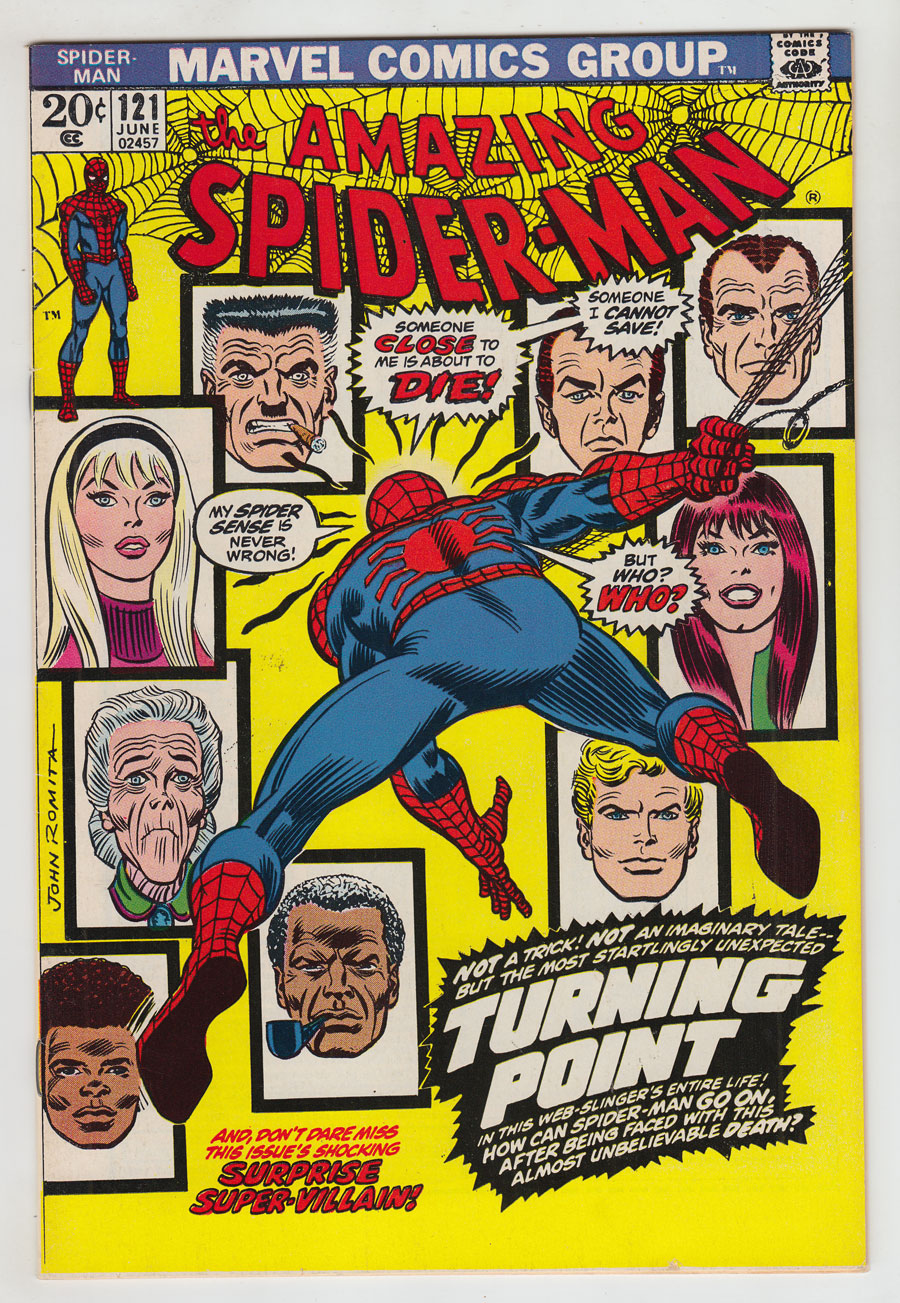
(Stock Image)

Highest Offer
1
Offers
PUBLISHER: Marvel
COMMENTS: white pgs
John Romita cover/art; Death of Gwen Stacy; Green Goblin app; COMIC BOOK IMPACT rating of 8 (CBI)
Read Description ▼
John Romita cover/art; Death of Gwen Stacy; Green Goblin app; COMIC BOOK IMPACT rating of 8 (CBI)
DESCRIPTION
white pgs
John Romita cover/art; Death of Gwen Stacy; Green Goblin app; COMIC BOOK IMPACT rating of 8 (CBI)There have been three influential moments that defined Peter Parker/Spider-Man; the spider bite which gave him his awesome powers, the death of his Uncle Ben which taught him the responsibility of those powers, and finally the tragic fate of Gwen Stacy, a devastating lesson showing that, despite his best efforts, some things are beyond his control. It had been previously unheard of to kill off such a focal character in a popular title but the death of Stacy became widely known as one the most monumental moments in comic book history and even started a trend of killing off spouses of heroes in comics known as "the Gwen Stacy syndrome.”
Writer Gerry Conway was initially asked by editors to kill off Aunt May, but instead opted for Gwen because he and artist John Romita Sr. felt that a perfect relationship betrayed the tragic essence of Spider-Man. This milestone issue easily cemented the Green Goblin as the arch-nemesis among Spider-Man's rouges gallery as the latter kidnaps Gwen Stacy and lures Spidey to the top of the George Washington bridge (illustrated as the Brooklyn Bridge). During the ensuing battle, Gwen is knocked off the top of the bridge and in a desperate attempt to save her, Spider-Man shoots a web catching her leg. As Parker pulls up the love of his life, he soon realizes that she’s already dead, as the same web meant to save her life caused the whiplash that snapped her neck. Although it initially shocked readers around the world Amazing Spider-Man #121 would be ultimately praised for its bravery and for paving the way for other grim, heart-wrenching stories in the future.
Artists Information
Gil Kane was a Latvian-born American comics artist whose career spanned the 1940s to the 1990s and virtually every major comics company and character. Kane co-created the modern-day versions of the superheroes Green Lantern and the Atom for DC Comics, and co-created Iron Fist with Roy Thomas for Marvel Comics. He was involved in such major storylines as that of The Amazing Spider-Man #96–98, which, at the behest of the U.S. Department of Health, Education, and Welfare, bucked the then-prevalent Comics Code Authority to depict drug abuse, and ultimately spurred an update of the Code. Kane additionally pioneered an early graphic novel prototype, His Name Is... Savage, in 1968, and a seminal graphic novel, Blackmark, in 1971. In 1997, he was inducted into both the Will Eisner Comic Book Hall of Fame and the Harvey Award Jack Kirby Hall of Fame.
John Romita was one of the driving forces behind Marvel's Silver Age, first taking up the reins on Amazing Spider-Man following the departure of Steve Ditko with issue #38. Romita's long run on Spider-Man would include the introduction of classic characters such as Mary Jane Watson, the Kingpin and many others. He would be a major contributor to the entire Marvel line throughout the 1970s — including designing the look of The Punisher. Romita's influence has since been felt for decades, including the emergence of John Romita, Jr. as one of the industry's top illustrators.
John Romita cover/art; Death of Gwen Stacy; Green Goblin app; COMIC BOOK IMPACT rating of 8 (CBI)There have been three influential moments that defined Peter Parker/Spider-Man; the spider bite which gave him his awesome powers, the death of his Uncle Ben which taught him the responsibility of those powers, and finally the tragic fate of Gwen Stacy, a devastating lesson showing that, despite his best efforts, some things are beyond his control. It had been previously unheard of to kill off such a focal character in a popular title but the death of Stacy became widely known as one the most monumental moments in comic book history and even started a trend of killing off spouses of heroes in comics known as "the Gwen Stacy syndrome.”
Writer Gerry Conway was initially asked by editors to kill off Aunt May, but instead opted for Gwen because he and artist John Romita Sr. felt that a perfect relationship betrayed the tragic essence of Spider-Man. This milestone issue easily cemented the Green Goblin as the arch-nemesis among Spider-Man's rouges gallery as the latter kidnaps Gwen Stacy and lures Spidey to the top of the George Washington bridge (illustrated as the Brooklyn Bridge). During the ensuing battle, Gwen is knocked off the top of the bridge and in a desperate attempt to save her, Spider-Man shoots a web catching her leg. As Parker pulls up the love of his life, he soon realizes that she’s already dead, as the same web meant to save her life caused the whiplash that snapped her neck. Although it initially shocked readers around the world Amazing Spider-Man #121 would be ultimately praised for its bravery and for paving the way for other grim, heart-wrenching stories in the future.
Artists Information
Gil Kane was a Latvian-born American comics artist whose career spanned the 1940s to the 1990s and virtually every major comics company and character. Kane co-created the modern-day versions of the superheroes Green Lantern and the Atom for DC Comics, and co-created Iron Fist with Roy Thomas for Marvel Comics. He was involved in such major storylines as that of The Amazing Spider-Man #96–98, which, at the behest of the U.S. Department of Health, Education, and Welfare, bucked the then-prevalent Comics Code Authority to depict drug abuse, and ultimately spurred an update of the Code. Kane additionally pioneered an early graphic novel prototype, His Name Is... Savage, in 1968, and a seminal graphic novel, Blackmark, in 1971. In 1997, he was inducted into both the Will Eisner Comic Book Hall of Fame and the Harvey Award Jack Kirby Hall of Fame.
John Romita was one of the driving forces behind Marvel's Silver Age, first taking up the reins on Amazing Spider-Man following the departure of Steve Ditko with issue #38. Romita's long run on Spider-Man would include the introduction of classic characters such as Mary Jane Watson, the Kingpin and many others. He would be a major contributor to the entire Marvel line throughout the 1970s — including designing the look of The Punisher. Romita's influence has since been felt for decades, including the emergence of John Romita, Jr. as one of the industry's top illustrators.

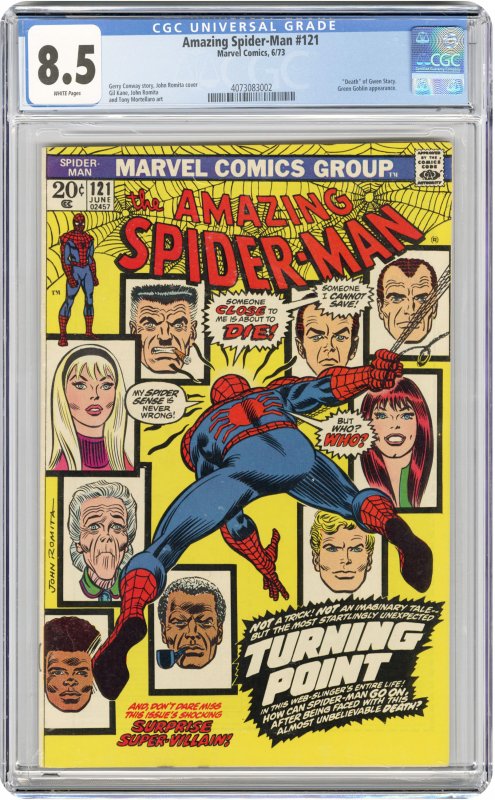
AMAZING SPIDER-MAN (1963-98; 2003-13) #121
Marvel CGC VF+: 8.5
white pages
John Romita cover/art; Death of Gwen Stacy; Green Goblin app; COMIC BOOK IMPACT rating of 8 (CBI)
John Romita cover/art; Death of Gwen Stacy; Green Goblin app; COMIC BOOK IMPACT rating of 8 (CBI)
white pages
John Romita cover/art; Death of Gwen Stacy; Green Goblin app; COMIC BOOK IMPACT rating of 8 (CBI)
John Romita cover/art; Death of Gwen Stacy; Green Goblin app; COMIC BOOK IMPACT rating of 8 (CBI)

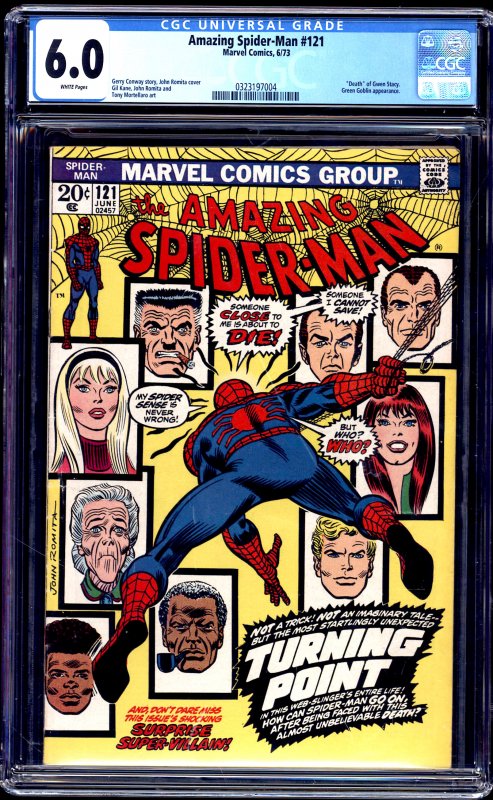
AMAZING SPIDER-MAN (1963-98; 2003-13) #121
Marvel CGC FN: 6.0
white pages pgs
John Romita cover/art; Death of Gwen Stacy; Green Goblin app; COMIC BOOK IMPACT rating of 8 (CBI)
John Romita cover/art; Death of Gwen Stacy; Green Goblin app; COMIC BOOK IMPACT rating of 8 (CBI)
white pages pgs
John Romita cover/art; Death of Gwen Stacy; Green Goblin app; COMIC BOOK IMPACT rating of 8 (CBI)
John Romita cover/art; Death of Gwen Stacy; Green Goblin app; COMIC BOOK IMPACT rating of 8 (CBI)


AMAZING SPIDER-MAN (SPAIN 1975-80) #121
Ediciones Vertice CGC VG+: 4.5
ow/white pages; Spanish edition
Spiderman El Hombre Arana V3 #60 (7/79); Spanish Edition; contains ASM #121-122 stories. Death of Gwen Stacy; John Romita / Rafael Lopez Espi cvr!
Spiderman El Hombre Arana V3 #60 (7/79); Spanish Edition; contains ASM #121-122 stories. Death of Gwen Stacy; John Romita / Rafael Lopez Espi cvr!
ow/white pages; Spanish edition
Spiderman El Hombre Arana V3 #60 (7/79); Spanish Edition; contains ASM #121-122 stories. Death of Gwen Stacy; John Romita / Rafael Lopez Espi cvr!
Spiderman El Hombre Arana V3 #60 (7/79); Spanish Edition; contains ASM #121-122 stories. Death of Gwen Stacy; John Romita / Rafael Lopez Espi cvr!


AMAZING SPIDER-MAN (1963-98; 2003-13) #121
Marvel CGC G/VG: 3.0
ow pages
John Romita cover/art; Death of Gwen Stacy; Green Goblin app; COMIC BOOK IMPACT rating of 8 (CBI)
John Romita cover/art; Death of Gwen Stacy; Green Goblin app; COMIC BOOK IMPACT rating of 8 (CBI)
ow pages
John Romita cover/art; Death of Gwen Stacy; Green Goblin app; COMIC BOOK IMPACT rating of 8 (CBI)
John Romita cover/art; Death of Gwen Stacy; Green Goblin app; COMIC BOOK IMPACT rating of 8 (CBI)
Highest Offer: $150

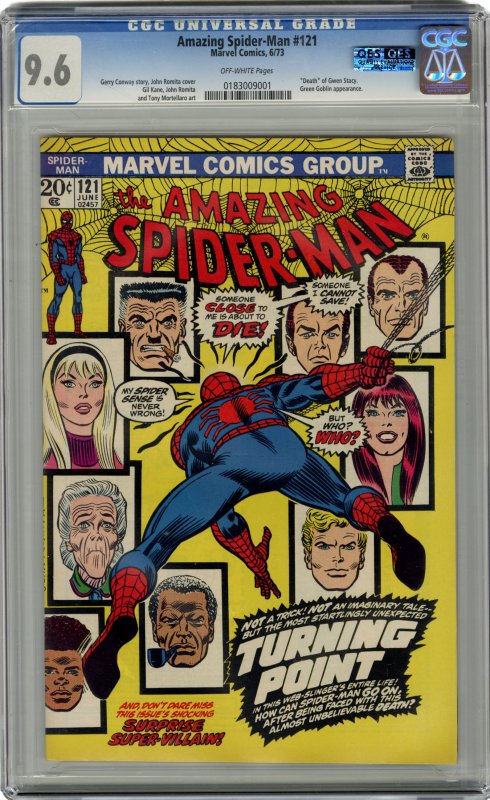


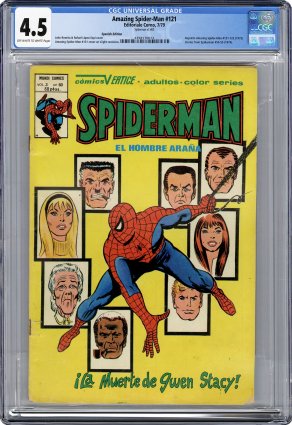
John Romita cover/art; Death of Gwen Stacy; Green Goblin app; COMIC BOOK IMPACT rating of 8 (CBI)
John Romita cover/art; Death of Gwen Stacy; Green Goblin app; COMIC BOOK IMPACT rating of 8 (CBI)